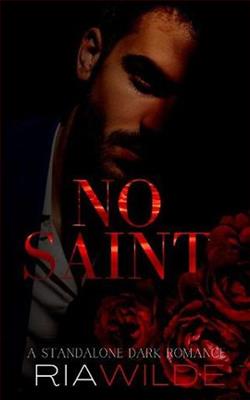Ria Wilde’s No Saint is a gripping exploration of love, power, and the complexities of human nature, set against the dark backdrop of organized crime. The novel introduces us to Gabriel Saint, a character who embodies the duality of man—both monster and potential savior. Wilde deftly navigates the murky waters of morality, making readers question the very definitions of good and evil.
The story unfolds in the city of Redhill, where Gabriel Saint reigns as the heir to a notorious crime family. From the outset, Wilde establishes a palpable tension, as the protagonist finds herself ensnared in a web of violence and power dynamics. The blurb hints at a classic trope of forced marriage, but Wilde elevates this narrative by infusing it with emotional depth and complexity. The protagonist, whose name remains undisclosed, is not merely a victim; she is a fighter, determined to reclaim her agency even in the face of overwhelming odds.
One of the most compelling aspects of No Saint is the character development. Gabriel Saint is initially portrayed as a ruthless figure, a man whose reputation precedes him as the “devil” of Redhill. However, as the story progresses, Wilde peels back the layers of his character, revealing vulnerabilities and desires that challenge the reader’s initial perceptions. This transformation is not only believable but also poignant, as it reflects the idea that everyone has a story worth understanding. The dynamic between Gabriel and the protagonist evolves from one of captor and captive to a more nuanced relationship, filled with tension, attraction, and ultimately, a quest for mutual understanding.
The themes of power and control are intricately woven throughout the narrative. Gabriel’s initial dominance is palpable, yet Wilde skillfully illustrates how power can be both a weapon and a shield. The protagonist’s struggle against her circumstances becomes a metaphor for the broader fight against oppression. Wilde does not shy away from depicting the brutality of the mafia world, but she also highlights the strength and resilience of her characters. This duality adds a layer of realism to the story, making it resonate with readers who appreciate depth in character arcs.
Moreover, the setting of Redhill serves as a character in its own right. Wilde paints a vivid picture of this gritty city, filled with danger and allure. The clifftop house where much of the story takes place becomes a symbol of both entrapment and refuge. It is here that the protagonist confronts her feelings for Gabriel, and the isolation of the setting amplifies the emotional stakes. The atmosphere is thick with tension, and Wilde’s descriptive prose immerses the reader in the world she has created.
Wilde’s writing style is engaging and fluid, making it easy for readers to become absorbed in the story. The dialogue is sharp and realistic, capturing the complexities of relationships in high-stakes environments. The pacing is well-executed, with moments of intense action balanced by quieter, introspective scenes that allow for character reflection. This balance keeps the reader invested in the characters’ journeys, as they navigate their tumultuous relationship amidst external threats.
Another notable theme in No Saint is the exploration of love in its many forms. Wilde challenges the notion of romantic love as purely idyllic, instead presenting it as a force that can be both destructive and redemptive. The protagonist’s initial vow to make Gabriel’s life miserable evolves into a deeper understanding of his motivations and desires. This transformation is beautifully portrayed, as the characters grapple with their feelings in a world that often prioritizes power over connection.
Wilde’s ability to create tension is commendable, particularly as the story progresses towards its climax. The stakes are raised not only by the external threats posed by rival factions but also by the internal conflicts within the characters themselves. As the protagonist uncovers more about Gabriel’s past and the reasons behind his actions, the reader is drawn into a web of intrigue that keeps them guessing until the very end.
In comparison to other works in the genre, such as Beautiful Disaster by Jamie McGuire or Twisted Love by Ana Huang, No Saint stands out for its nuanced portrayal of the anti-hero. While many stories in the mafia romance genre often lean heavily on the trope of the brooding bad boy, Wilde’s Gabriel is a more complex figure, one who invites empathy rather than mere admiration. This depth adds a richness to the narrative that is often lacking in similar stories.
In conclusion, Ria Wilde’s No Saint is a captivating read that delves into the intricacies of love, power, and redemption. With well-developed characters, a gripping plot, and a richly imagined setting, the novel offers a fresh take on the mafia romance genre. Wilde’s exploration of the human condition, coupled with her ability to create tension and emotional depth, makes this book a must-read for fans of dark romance. As the protagonist and Gabriel navigate their tumultuous relationship, readers are left to ponder the true nature of love and the sacrifices it demands.























Reviews 0
Post a Reviews: